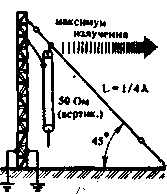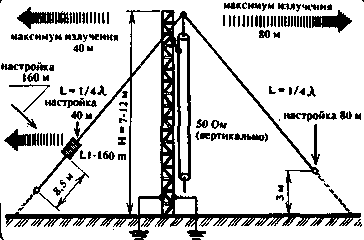Antenna type "sloper" (tilted dipole) is one of the most common. Especially hams often use it in the range of 80 and 40 m, where for holding DX relations is very important to have pinned to the ground radiation in the vertical plane.
There are several variants of antenna structures "sloper". In Fig.1 shows a "sloper" length 1/2L, Rin = 75 Ω.

Fig.1

When using a metal mast, the maximum radiation is in the direction of reducing leaf antenna. If the mast is used dielectric pillar or a tree, the graph will be bidirectional. In Fig.2 shows a "sloper" 1/4L. Rin = 50 Ω. Metal mast should have a pretty good grounding. since this affects the efficiency of the antenna.

Fig.2
On the basis of such antenna can be made "sloper" 160. 80 and 40 meters. It works very well on N-H bands, and when using an antenna matching device it can be used 20. 15, 10 meters.
The antenna shown in Fig.3. Lengthening the coil 160-meter band performed on the dielectric frame with a diameter of 41 mm, 68 turns (turn to turn), wire sew-2 with a diameter of 1 mm., Its inductance should be about 87,2 µh. As a grounded mast here is part of the antenna, metal guy wire must be broken insulators. Configurable antenna with SWR meter in the locations shown in Fig.3.

Fig.3
When using matching device configuration is required, just enough to properly perform the arm length of the antenna. When using a multi-range version of the shoulder "And" must be, designed for 3500 kHz. But the most effective is the "sloper" length 1L (Fig.4). This antenna requires a somewhat larger area for its installation, but this is justified by its performance. Rin=75 Ω. The total length of the antenna curtain is determined by the formula:

Fig.4
Lm=(936*0,305)/f MHz
Side Am=(702*0,305)/f MHz
Side VM=(234*0,305)/f MHz
If you install a single mast 3-4 such antenna, with an antenna switch, you can choose different directions of radiation. Antenna not participating in the work, shall be automatically grounded.
Author: I. Podgorny UC2AGL, Minsk; Publication: N. Bolshakov, rf.atnn.ru






